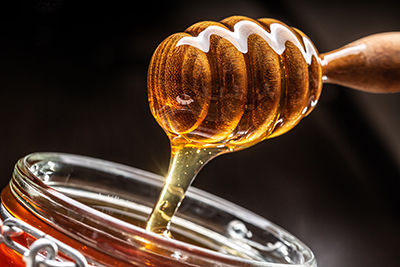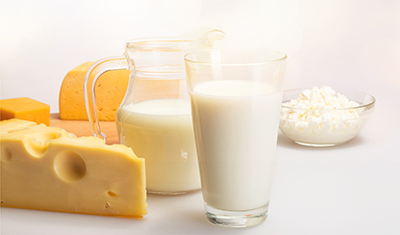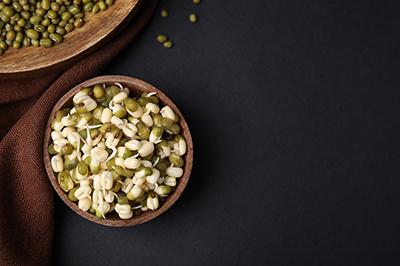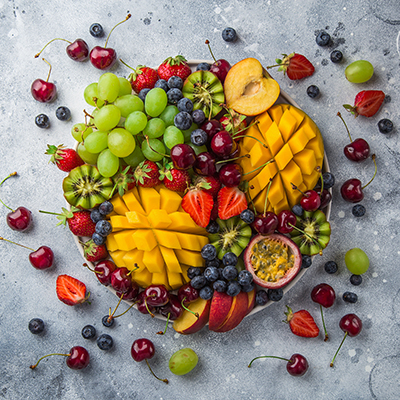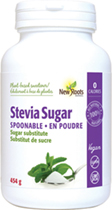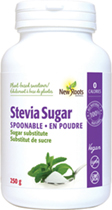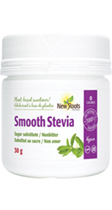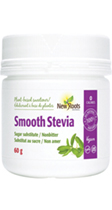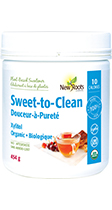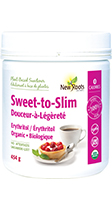Sugar: What Is It? And What Else Tastes Like It?
There is a lot of information about sugar and its impact upon our health, but how many of us really know what sugar is, and how it differs from other sugar-like substances?
Nutritionally, sugar refers to any carbohydrate. Carbohydrates are one of the four key macronutrients found in food (the others being protein, fat, and fibre).[1] On a biochemical level, “sugar” refers to the base unit that makes up carbohydrates, whereas from a nutritional perspective, “sugar” is a general term for any sweet-tasting carbohydrate made up of one or two simple sugar units—these are called monosaccharides and disaccharides, respectively.[2]
Both groups are composed of three types, each commonly found in food: glucose, fructose, and galactose (single sugars); and maltose, sucrose, and lactose (two simple sugars bonded together).[3] These six simple sugars each have different functions in plants and animals and can have different health effects when consumed.
Glucose
Glucose (also known as dextrose) is the most important monosaccharide overall, as it is the key energy sugar used in both animal and plant metabolism. In animals, glucose is the compound referred to as “blood sugar”: glucose is what our bodies run on. Comparatively, plants produce glucose via photosynthesis (a chemical reaction fuelled by sunlight that creates sugar out of carbon dioxide and water), then combine it in long, complex chains for energy storage (starch).[4] Starchy foods, when eaten, convert to glucose in the gut. Such foods include grains, potatoes, legumes, corn, peas, squash, and sweet potatoes.[5] Free glucose is typically only found in honey, corn syrup, and high-fructose corn syrup (also called glucose-fructose syrup, as its composition is 50% glucose and 50% fructose).[6], [7]
Fructose
Fructose is the sweetest monosaccharide and is commonly found in plants—it is the sugar that gives fruit their sweetness. Honey is very high in fructose, as are most fruits, berries, and some root vegetables. High-fructose corn syrup is also high in fructose (50% fructose, as mentioned above).[8]
Galactose
Galactose is the third most common monosaccharide sugar found in food. It is mostly found in dairy products and is rarely free like glucose or fructose; it is almost always bound to another sugar, usually glucose, to make the disaccharide lactose.[9]
Lactose
Lactose is a disaccharide (glucose bound to galactose) and is almost exclusively found in dairy products and foods made from dairy: milk, yogurt, cheese, ice cream, cream cheese, whipping cream, etc.[10], [11] However, not everyone has enough lactase—the enzyme to digest lactose (to break the glucose-galactose bond)—which can lead to symptoms of lactose intolerance (bloating, abdominal pain, cramping, gas, and diarrhea).[12] Folks with lactose intolerance may be able to take supplemental lactase enzyme to help with lactose digestion or choose lactose-free dairy or dairy-free alternative products.[13]
Sucrose
When people buy sugar at the store, this is the compound they’re purchasing.[14] Sucrose is a glucose-fructose disaccharide that is naturally occurring in maple syrup and honey as well as many fruits and vegetables (especially beets, sugarcane, and sweet potatoes).[15] When concentrated and extracted, sugar is made. Beet sugar, cane sugar, white sugar, inverted sugar, icing sugar, demerara sugar, turbinado sugar, brown sugar, raw sugar, molasses… are all types of sugar containing at least 99.8% sucrose.[16] These sugars are commonly used in the manufacture of baked goods and sweet treats, and candies.
Maltose
Maltose is a disaccharide made of two glucose molecules bonded together. It is found primarily in sprouted grains, thus explaining why sprouted grain products taste a bit sweeter than other similar grain products.[17] Maltose is not as sweet as sucrose (about 30 to 60% less) but still breaks down quickly to glucose in the digestive system. It is commonly used as an ingredient in Asian cooking or added to processed food as a sweetener instead of high-fructose corn syrup or sucrose.[18]
Simple sugars, no matter their source or type, are rapidly digested and absorbed by the digestive system, resulting in increased blood sugar. Excess consumption of sugar can lead to insulin resistance and result in several health challenges especially obesity, metabolic syndrome, and type 2 diabetes.[19] To help prevent this, the American Heart Association recommends a maximal consumption of 6 tsp or 24 g of sugar per day for adult women, and 9 tsp or 36 g of sugar for adult men. For children aged 2 to 18, no more than 6 tsp or 24 g, and no added sugars are recommended for kids under 2 years old.[20]
Now, let’s have a look at some sugar-like substances…
Sugar Alcohols
Sugar alcohols are sweet-tasting molecules that look like monosaccharides but have at least one hydroxy group (an oxygen bound to a hydrogen), making them molecularly different from simple sugars.[21] They are called sugar alcohols (or “polyols”) because of the hydroxyl group, which is also found in ethanol (alcohol), but they are not “alcoholic” in nature.[22] Common sugar alcohols include mannitol, sorbitol, xylitol, erythritol, lactitol, isomalt, maltitol, and “hydrogenated starch hydrolysates.”[23], [24]
For the most part, these are naturally found in fruits, berries, as well as birch sap, and can be extracted and added to food as a “sugar-free” sweetener.[25] These compounds are not calorie-free, however; they contain about ½ to ⅓ the calories of the equivalent amount of sucrose, but they are more slowly metabolized and may be incompletely absorbed, so they don’t usually affect blood sugar as quickly as table sugar.[26], [27], [28] Polyols, found naturally in fruits or added to processed foods, can cause bloating and diarrhea in sensitive people or when consumed in excessive amounts.[29]
Stevia
Stevia is a zero-calorie sweetener derived from the stevia plant.[30] It is 200–300 times sweeter than sucrose and is “generally recognized as safe” by the U.S. Food and Drug Administration.[31], [32] It is commonly added as a sweetener to beverages, candies, and baked goods.[33] Stevia does not affect insulin and can help maintain a healthy blood-sugar balance.
Sucralose
Sucralose, also known under the trade name Splenda, is a zero-calorie sweetener about 600 times sweeter than sugar.[34], [35] It is manufactured from sucrose, but chemically modified: It doesn’t break down in the digestive system and is minimally absorbed.[36], [37] There is some concern that it may disrupt the gut microbiome and influence blood-sugar levels, but it is generally considered safe to consume in small amounts.[38]
Aspartame
Aspartame is a low-calorie sweetener about 200 times sweeter than sugar, often blended with other sweeteners as it has a slight bitter taste.[39] It is typically added to beverages, dairy products, desserts, and candies, as well as in Equal® sweetener.[40]
Acesulfame Potassium
Acesulfame potassium is a zero-calorie sweetener about 200 times sweeter than sucrose.[41] It is also called Ace K or acesulfame K and is the primary ingredient in the original Equal®.[42] It is heat-stable, so it is added to many products: baking, beverages, deserts, candies, etc.
There are a lot of sweeteners out there. Knowing what sugar is and how it compares to nonsugar sweeteners, as well as the health impacts of each, allows you to make informed choices and improve your overall health. Sweet dreams!
 Dr. Katie DeGroot, BSc, ND, MScN
Dr. Katie DeGroot, BSc, ND, MScN
Dr. DeGroot is an Alberta-registered naturopathic doctor who also holds a Master of Science in Nutrition. She offers nutritionally focused care and has a special interest in digestive issues and supportive mental health-care.
drkatiedegroot.ca
[1] Government of Canada. Dietary reference intakes. https://www.canada.ca/en/health-canada/services/food-nutrition/healthy-eating/dietary-reference-intakes/tables/reference-values-macronutrients-dietary-reference-intakes-tables-2005.html · Updated 2006‑06‑29. Accessed 2021‑10‑30.
[2] Powell, T. “Types of carbohydrates.” Nutrition FN 225. Carbohydrates. https://media.lanecc.edu/users/powellt/FN225OER/Carbohydrates/FN225Carbohydrates2.html · Updated 2018‑10‑12. Accessed 2022‑08‑02.
[3] Powell. “Types of carbohydrates.”
[4] Powell. “Types of carbohydrates.”
[5] Alberta Health Services. Carbohydrate in foods. https://www.albertahealthservices.ca/assets/info/nutrition/if-nfs-carbohydrate-in-foods-pictorial.pdf · Updated 2017‑03.
[6] Alberta Health Services. Carbohydrate in foods.
[7] UnlockFood.ca. What you need to know about high fructose corn syrup. https://www.unlockfood.ca/en/Articles/Carbohydrate-and-Sugar/What-You-Need-to-Know-About-High-Fructose-Corn-Syr.aspx · Updated 2018‑05‑10. Accessed 2022‑07‑31.
[8] Powell. “Types of carbohydrates.”
[9] Powell. “Types of carbohydrates.”
[10] Powell. “Types of carbohydrates.”
[11] Alberta Health Services. Carbohydrate in foods.
[12] Powell. “Types of carbohydrates.”
[13] Webb, D. “The latest on lactose intolerance: What it is, how it’s diagnosed, and tips for counseling clients.” Today’s Dietitian, Vol. 17, No. 5 (2015): 38. https://www.todaysdietitian.com/newarchives/050515p38.shtml · Accessed 2022‑08‑02.
[14] The Canadian Sugar Institute. Types of sugar. https://sugar.ca/sugar-basics/types-of-sugar · Accessed 2022‑07‑31.
[15] Powell. “Types of carbohydrates.”
[16] The Canadian Sugar Institute. Types of sugar.
[17] Powell. “Types of carbohydrates.”
[18] Zhu, M. “Maltose (麦芽糖, mài yá táng).” Omnivore’s Cookbook. https://omnivorescookbook.com/pantry/maltose/ · Published 2019‑10‑23. Accessed 2022‑07‑31. (Updated 2022‑10‑26.)
[19] The Nutrition Source. Added sugar. Harvard T.H. Chan School of Public Health. https://www.hsph.harvard.edu/nutritionsource/carbohydrates/added-sugar-in-the-diet/ · Accessed 2022‑07‑31.
[20] The Nutrition Source. Added sugar.
[21] Yale New Haven Hospital. Eat any sugar alcohol lately? https://www.ynhh.org/services/nutrition/sugar-alcohol · Accessed 2022‑08‑02.
[22] Yale New Haven Hospital. Eat any sugar alcohol lately?
[23] Yale New Haven Hospital. Eat any sugar alcohol lately?
[24] Diabetes Education Online. Counting sugar alcohols. https://dtc.ucsf.edu/living-with-diabetes/diet-and-nutrition/understanding-carbohydrates/counting-carbohydrates/learning-to-read-labels/counting-sugar-alcohols/ · Accessed 2022‑08‑02.
[25] Yale New Haven Hospital. Eat any sugar alcohol lately?
[26] Yale New Haven Hospital. Eat any sugar alcohol lately?
[27] Diabetes Education Online. Counting sugar alcohols.
[28] MyHealth.Alberta.ca. Sugar alcohols. https://myhealth.alberta.ca/Health/Pages/conditions.aspx?hwid=zp3568 · Updated 2021‑09‑08. Accessed 2022‑08‑02.
[29] Diabetes Education Online. Counting sugar alcohols.
[30] TRC Natural Medicines. Stevia. https://naturalmedicines.therapeuticresearch.com/databases/food,-herbs-supplements/professional.aspx?productid=682 · Accessed 2022‑07‑31.
[31] TRC Natural Medicines. Stevia.
[32] Food Insight. Everything you need to know about stevia sweeteners. https://foodinsight.org/everything-you-need-to-know-about-stevia-sweeteners/ · Published 2021‑04‑20. Accessed 2022‑08‑02.
[33] Food Insight. Everything you need to know about stevia sweeteners.
[34] Cleveland Clinic. Is sucralose (Splenda) bad for you? https://health.clevelandclinic.org/is-sucralose-splenda-bad-for-you/ · Published 2021‑01‑12. Accessed 2022‑08‑02.
[35] Food Insight. Everything you need to know about sucralose. https://foodinsight.org/everything-you-need-to-know-about-sucralose/ · Published 2021‑04‑28. Accessed 2022‑08‑02.
[36] Cleveland Clinic. Is sucralose (Splenda) bad for you?
[37] Food Insight. Everything you need to know about sucralose.
[38] Cleveland Clinic. Is sucralose (Splenda) bad for you?
[39] Food Insight. Everything you need to know about aspartame. https://foodinsight.org/everything-you-need-to-know-about-aspartame/ · Published 2020‑12‑04. Accessed 2022‑08‑02.
[40] Food Insight. Everything you need to know about aspartame.
[41] Food Insight. Everything you need to know about acesulfame potassium. https://foodinsight.org/everything-you-need-to-know-about-acesulfame-potassium/ · Published 2022‑04‑13. Accessed 2022‑08‑02.
[42] Food Insight. Everything you need to know about acesulfame potassium.

 Stores
Stores
